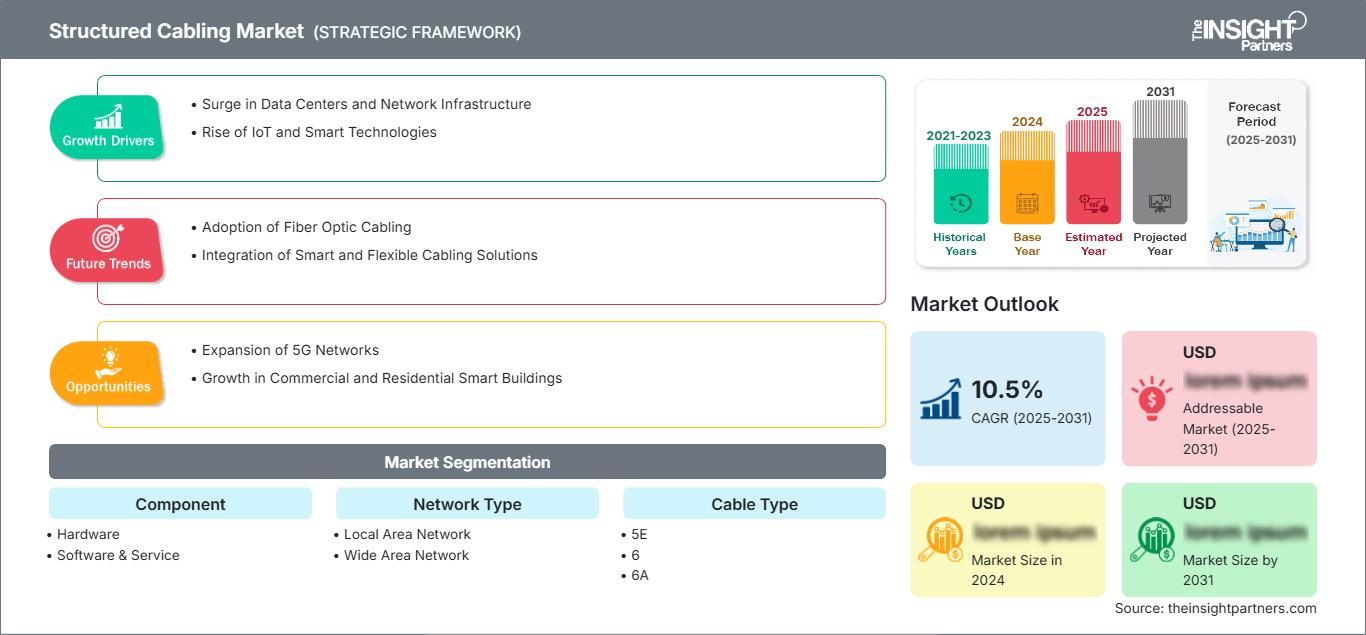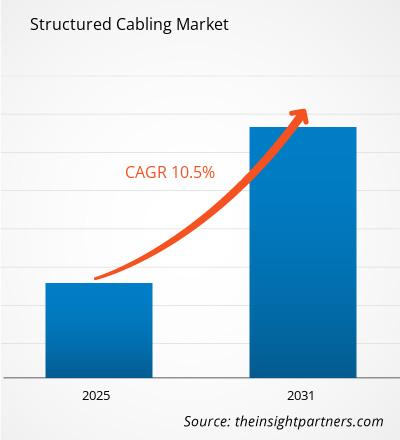The Structured Cabling Market is expected to register a CAGR of 10.5% from 2025 to 2031, with a market size expanding from US$ XX million in 2024 to US$ XX Million by 2031.
The report is segmented by Component (Hardware and Software & Service), Network Type (Local Area Network and Wide Area Network), Cable Type (5E, 6, 6A, and Others), and End Use (Government & Defense, Healthcare, IT & Telecom, Manufacturing, Residential & Commercial Buildings, Transportation, and Others). The global analysis is further broken-down at regional level and major countries. The Report Offers the Value in USD for the above analysis and segments.
Purpose of the Report
The report Structured Cabling Market by The Insight Partners aims to describe the present landscape and future growth, top driving factors, challenges, and opportunities. This will provide insights to various business stakeholders, such as:
- Technology Providers/Manufacturers: To understand the evolving market dynamics and know the potential growth opportunities, enabling them to make informed strategic decisions.
- Investors: To conduct a comprehensive trend analysis regarding the market growth rate, market financial projections, and opportunities that exist across the value chain.
- Regulatory bodies: To regulate policies and police activities in the market with the aim of minimizing abuse, preserving investor trust and confidence, and upholding the integrity and stability of the market.
Structured Cabling Market Segmentation
Component
- Hardware
- Software & Service
Network Type
- Local Area Network
- Wide Area Network
Cable Type
- 5E
- 6
- 6A
End Use
- Government & Defense
- Healthcare
- IT & Telecom
- Manufacturing
- Residential & Commercial Buildings
- Transportation
You will get customization on any report - free of charge - including parts of this report, or country-level analysis, Excel Data pack, as well as avail great offers and discounts for start-ups & universities
Structured Cabling Market: Strategic Insights

-
Get Top Key Market Trends of this report.This FREE sample will include data analysis, ranging from market trends to estimates and forecasts.
Structured Cabling Market Growth Drivers
- Surge in Data Centers and Network Infrastructure: The growing demand for data centers and expanded network infrastructure is a significant driver for the structured cabling market. As businesses and cloud services providers require high-speed, reliable connectivity, structured cabling solutions offer essential support for efficient data transmission and scalability. This trend is accelerating as more companies invest in enhancing their network infrastructure to meet growing data demands.
- Rise of IoT and Smart Technologies: The proliferation of IoT devices and smart technologies across industries is fueling the need for efficient and reliable cabling systems. Structured cabling provides the backbone for seamless communication between IoT devices, enabling improved data transfer speeds and network management. As IoT adoption continues to grow, the structured cabling market is benefiting from its role in supporting this technology.
Structured Cabling Market Future Trends
- Adoption of Fiber Optic Cabling: A major trend in the structured cabling market is the increasing shift towards fiber optic cabling. Fiber optics offer higher bandwidth, faster data transmission speeds, and better reliability over longer distances compared to traditional copper cabling. As the need for higher data rates grows in sectors like telecommunications, data centers, and enterprise networks, fiber optic solutions are becoming more prevalent.
- Integration of Smart and Flexible Cabling Solutions: The demand for smart and flexible cabling systems is growing, particularly with the rise of smart buildings and automated systems. Structured cabling is evolving to support these smart environments, offering systems that are easier to install, manage, and scale. Flexible, modular cabling solutions that can adapt to changing requirements are becoming a preferred choice for new and retrofitted buildings.
Structured Cabling Market Opportunities
- Expansion of 5G Networks: The rollout of 5G networks presents a significant opportunity for the structured cabling market. As 5G infrastructure requires advanced cabling solutions for improved data speeds and connectivity, structured cabling systems, especially fiber optics, will be essential for supporting the high-speed, low-latency demands of 5G networks. This provides a lucrative growth avenue for manufacturers.
- Growth in Commercial and Residential Smart Buildings: The rise of smart buildings, particularly in commercial and residential sectors, offers an opportunity for structured cabling solutions. As buildings become more connected and automated, there is a greater need for reliable, scalable, and high-performance cabling infrastructure. Structured cabling systems can support the growing connectivity requirements of IoT devices, lighting, HVAC, and security systems.
Structured Cabling Market Regional Insights
The regional trends and factors influencing the Structured Cabling Market throughout the forecast period have been thoroughly explained by the analysts at The Insight Partners. This section also discusses Structured Cabling Market segments and geography across North America, Europe, Asia Pacific, Middle East and Africa, and South and Central America.
Structured Cabling Market Report Scope
| Report Attribute | Details |
|---|---|
| Market size in 2024 | US$ XX million |
| Market Size by 2031 | US$ XX Million |
| Global CAGR (2025 - 2031) | 10.5% |
| Historical Data | 2021-2023 |
| Forecast period | 2025-2031 |
| Segments Covered |
By Component
|
| Regions and Countries Covered |
North America
|
| Market leaders and key company profiles |
|
Structured Cabling Market Players Density: Understanding Its Impact on Business Dynamics
The Structured Cabling Market is growing rapidly, driven by increasing end-user demand due to factors such as evolving consumer preferences, technological advancements, and greater awareness of the product's benefits. As demand rises, businesses are expanding their offerings, innovating to meet consumer needs, and capitalizing on emerging trends, which further fuels market growth.

- Get the Structured Cabling Market top key players overview
Key Selling Points
- Comprehensive Coverage: The report comprehensively covers the analysis of products, services, types, and end users of the Structured Cabling Market, providing a holistic landscape.
- Expert Analysis: The report is compiled based on the in-depth understanding of industry experts and analysts.
- Up-to-date Information: The report assures business relevance due to its coverage of recent information and data trends.
- Customization Options: This report can be customized to cater to specific client requirements and suit the business strategies aptly.
The research report on the Structured Cabling Market can, therefore, help spearhead the trail of decoding and understanding the industry scenario and growth prospects. Although there can be a few valid concerns, the overall benefits of this report tend to outweigh the disadvantages.
Frequently Asked Questions
What are the options available for the customization of this report?
What are the future trends of the structured cabling market?
Which are the key players in the structured cabling market?
What are the driving factors impacting the structured cabling market?
1. High-Speed Internet and High-Demand Data Transmission Growth in the Industry.
2.Expansion of Data Centers and Cloud Computing
What is the expected CAGR of the ?
- Historical Analysis (2 Years), Base Year, Forecast (7 Years) with CAGR
- PEST and SWOT Analysis
- Market Size Value / Volume - Global, Regional, Country
- Industry and Competitive Landscape
- Excel Dataset
Recent Reports
Testimonials
Reason to Buy
- Informed Decision-Making
- Understanding Market Dynamics
- Competitive Analysis
- Identifying Emerging Markets
- Customer Insights
- Market Forecasts
- Risk Mitigation
- Boosting Operational Efficiency
- Strategic Planning
- Investment Justification
- Tracking Industry Innovations
- Aligning with Regulatory Trends





















 Get Free Sample For
Get Free Sample For